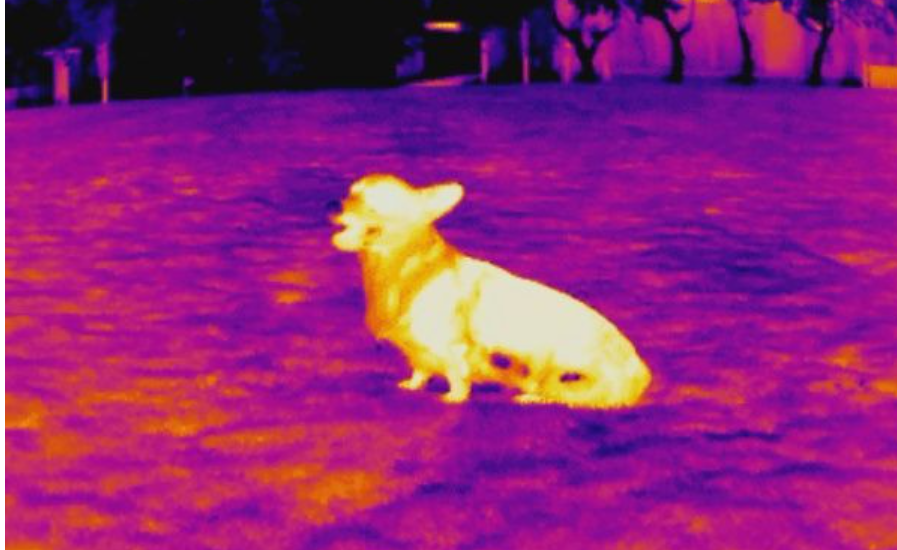
All the objects of nature, both in arctic sea ice, and the flame, the human body, even extremely cold universe deep space, as long as their temperature above absolute zero - 273 ℃, there will be infrared radiation, and thermal imaging is through the non-contact detection of infrared energy (heat), and transform it into electrical signals that, in turn, generate thermal image and temperature on the display, And can calculate the temperature value of a detection equipment. The above is the definition of thermal imaging, in fact, has explained the problem, thermal imaging is a kind of equipment for temperature imaging, accurate temperature difference (and the ambient temperature, focal plane temperature, etc.).

Figure.1

In fact, the real thermal imaging image is shown in Figure 1 above, and Figure 2 is also thermal imaging, but Figure 2 is pseudo color, because the real thermal imaging image is gray scale and single channel, and the pseudo color in Figure 2 is artificially mapped to enhance the visual difference. So how is thermal imaging different from visible light in our real world?
Infrared thermal imaging differs from visible light in many ways, mainly for the following reasons:
(1) Imaging principle
Imaging principle is basically the same, imaging equipment to image the light wave within a certain wavelength range, the nature of visible light wavelength range from 0.39μm to 0.78μm, and infrared thermal radiation wavelength range from 0.75μm to 1000μm. Thermal imaging does not depend on temperature (temperature difference). Why we mention infrared thermal radiation? This should emphasize another fact: As long as their temperature is higher than absolute zero -273℃, they will have infrared radiation. Thermal imaging is to detect infrared energy (heat) through non-contact, and convert it into electrical signals, and then generate thermal images and temperature values on the display. Maybe I'm being a little verbose, but if you want to understand thermal imaging, it's important to keep in mind that thermal imaging devices also pick up light waves (in the infrared), just not visible to the human eye.
(2) Detector
Imaging equipment core detector, visible light CCD, CMOS, thermal imaging refrigeration type, non-refrigeration type (the difference lies in whether there is a small refrigerator refrigeration, mainly used to control the focal plane temperature, remember the previous special emphasis on temperature difference? The focal plane temperature is used as a reference temperature. The main difference lies in that the visible CCD/CMOS can sense the light wave in the visible band, while the thermal imaging detector can sense the thermal radiation light wave in the infrared band. Infrared thermal imaging detectors are divided into many kinds according to the different manufacturing process, packaging materials, etc. The macro feeling is that infrared thermal imaging detectors are more expensive than visible CCD, expensive out of an order of magnitude or more, which is one of the main reasons for the narrow application range of infrared thermal imaging. Infrared detector manufacturing and technology giants or Europe and the United States a few more severe, but in recent years at home was developed several very good manufacturers, such as yantai iresearch, infrared, zhejiang, guangzhou gold Sartre, etc., several security giant also has positive entry field of infrared detector, such as sea Kang Wei shadow, zhejiang dahua, and so on. In the next few years, whether the thermal imaging field to achieve a large explosion, or to see these detector manufacturers, can bring down the price, widely used in the civilian market.
(3) Lens
The main difference lies in that the thermal imaging lens must be made of special materials. The main reason is that the infrared thermal radiation cannot pass through glass (silicon), so special metallic materials such as germanium and chromium are used. This also leads to the price of thermal imaging lens is also higher than the price of the optical lens, but also increases the price of the whole machine.
(4) Images
The difference of images is that visible light imaging is color, RGB three channels, but thermal imaging is gray, the original thermal imaging image is single channel, we see in the market color thermal imaging is false color, is artificial late forced conversion, general false color will have many kinds, but also can be configured. In addition, the image size of thermal imaging is smaller than that of visible light. Now the typical thermal imaging has 384 and 640, and the largest 1024 has only come out in recent years, but the visible light is now 1080P or larger 400W, etc., which has become the mainstream in practical application.
(5) Application scenarios
Visible light is generally used in the daytime, or at night with good light conditions. Although many starlight equipment comes out now, the imaging effect is not satisfactory in the night with poor light, but thermal imaging can work around the clock, and there is no light at night, it can still image. Of course, thermal imaging also has shortcomings. After all, it depends on temperature difference for imaging, so when it is rainy and low temperature, the imaging quality will also decline, or even fuzzy. For example, if a blue dress falls into the blue sea, it will not be visible with visible light equipment. An object with a uniform surface temperature of 30° is placed in a scene with a temperature of 30° and cannot be seen with a thermal imaging device. Therefore, in practical application, appropriate schemes should be formulated according to the scenarios and equipment characteristics.
